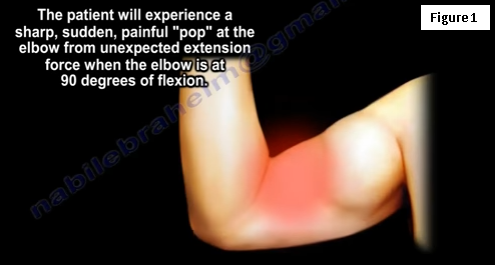The Hook Test is used to diagnose a distal biceps tendon rupture, avulsion, or a tear. The biceps tendon inserts into the proximal radius at the radial tuberosity at the elbow. When the biceps tendon ruptures, it will cause pain at the elbow. It is a single traumatic event with eccentric force on the flexed elbow. The patient will experience a sharp, sudden, painful “pop” at the elbow from unexpected extension force when the elbow is at 90 degrees of flexion (Figure 1). The condition occurs in middle aged men, usually involving the dominant extremity. There might be ecchymosis at the elbow and weakness of supination and flexion of the elbow. There may be a palpable defect (Figure 2) with proximal retraction of the biceps muscle belly. If rupture of the tendon is not diagnosed and repaired, then there will be a loss of 40-50% of supination and 30% of flexion of the elbow.

The hook test is performed to diagnose rupture or tear of the distal biceps tendon. The examiner will use the index finger to hook the biceps tendon from the lateral side of the elbow.
To perform the hook test, the patient will need to flex the elbow at a 90 degree angle and fully supinate the forearm. Then, the physician will use their index finger to hook the lateral edge of the biceps tendon. If the tendon is intact or partially torn, the finger can be inserted below the tendon and “hook” it. If the tendon cannot be hooked, then this indicates a complete tear of the distal biceps tendon (Figure 3). The patient may be able to perform this test on their own.

There may be false positives involved with the Hook test, such as with partial tears of the distal biceps, an intact lacertus fibrosus, or mistakenly hooking the brachialis tendon.

Another test to diagnose the distal biceps tendon rupture is the Squeeze Test (Figure 4), which is similar to the Thompson’s Test—a method used to diagnose an Achilles tendon rupture. For the Squeeze test, you will ask the patient to flex their elbow to 80 degrees and keep the forearm in some pronation, then you will squeeze the biceps with one hand or with two hands. Supination of the forearm will occur if the biceps is intact. NO supination of the forearm will occur if the biceps is torn.

The problem with diagnosing distal biceps tendon tears, is differentiating between partial and complete tears because both have the same clinical pictures (Figure 5). You could see a palpable defect with a complete distal biceps tear which could help confirm a diagnosis. Partial distal biceps tendon tears are rare and are frequently misdiagnosed and underdiagnosed. The patient will have pain in the elbow and the patient will have a normal Hook Test. In these cases, an MRI may be helpful in diagnosing a partial tear of the distal biceps tendon. An MRI may not be needed in all cases, for example, when there is a complete tear. An MRI will diagnose the tear, the degree of retraction, and if the tear is complete or partial (Figure 6).

Originally published at www.huffingtonpost.com


